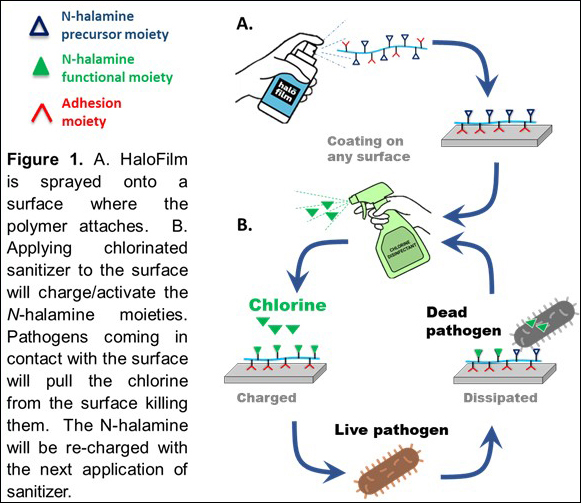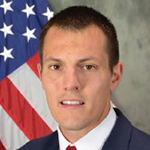Jennifer DiStefano
Editor, Intersections
Welcome to the Spring Edition of Intersections.
Since our last newsletter, the coronavirus has upended many of our normal practices and routines in unprecedented ways. However, materials scientists, along with the broader scientific community, have provided vast and varied contributions to this crisis through incredible creativity and flexibility. The MRS Government Affairs Committee (GAC) aims to understand the changes in the legislative policy environment resulting from coronavirus and opportunities for materials science to make continued impact on this and myriad other societal challenges. MRS is working hard to make sure that the materials research community is being heard and has input in developing effective government policy for support of materials science during this time. Here is the latest news.
In this issue, the value-added article highlights how federal investment in materials research resulted in robust antibacterial technology - particularly critical during a global pandemic - at Halomine.
MRS Government Affairs Committee (GAC) Chair, David Norton, highlights the key role advanced materials play in combating coronavirus and the importance of continued leadership in materials research.
Damon Dozier, MRS Director of Government Affairs, discusses how the coronavirus is impacting federal research funding, particularly related to health care, and recently introduced bipartisan legislation to renew national investment in public research and development.
Our Grassroots Subcommittee Chair, Boris Dyatkin, explains the importance of scientific advocacy during the current global health crisis and how the Grassroots Subcommittee is contributing to this mission.
Jennifer Nekuda Malik, Chair of the Advocacy Engagement Subcommittee, introduces the first
two materials success stories for education and advocacy efforts. See her update to learn how you can contribute an idea for a future materials success story.
Our Congressional Fellowship Program Chair, Ashley White, provides updates both on the selection process for the 2020-2021 MRS fellows and the activities of the current two fellows. Each current fellow provides
a personal account of how the coronavirus is affecting their experience working with Congress.
Congressional Visits Day Chair, Bill Hammetter, discusses preparations for the next Congressional Visits Day, following the cancellation of the spring event, and
asks members to submit examples of how their work has contributed towards the fight against COVID-19.
Finally, Jeremy Ward, Chair of the Government Agencies Subcommittee, discusses how research funding sessions at
MRS Meetings and the annual MRS-TMS summit with government agencies were impacted by the coronavirus and efforts to continue these activities in the future.
A Value-Added Materials Research Story

Greg Howard, on behalf of Ted Eveleth, CEO Halomine, Inc.
Halomine, Inc.’s HaloFilm™ Will Transform How We Sanitize Surfaces in Households, Hospitals and Beyond
Halomine™, is a Cornell University-based spin out company developing a suite of novel, long-acting, household and institutional products that create anti-microbial surfaces, including HaloFilm™, the company’s initial commercial product. Founded in 2018, Halomine has been aggressively expanding on their original research with assistance from the National Science Foundation, the United States Department of Agriculture’s Small Business Innovation Research Program (SBIR), the US Army’s xTechSearch program, and others.
Halomine is the result of a combination of technologies Dr. Qiao brought to Cornell from his time at Auburn University. Prof. Ma brought complementary technology from his days in Robert Langer’s lab at MIT. Together they have created and expanded on useful application of N-halamine chemistry.
Dr. Qiao started the company, licensed the technology for the first product from Cornell and received his first grant from USDA, focusing on food processing and food safety. After a year, he brought in an experienced CEO to help move the company forward. Little did Dr. Qiao know that the novel coronavirus would drastically accelerate Halomine’s timeline.
The COVID-19 pandemic has significantly raised the stakes in the battle against pathogens.
 Self-sanitizing coatings, i.e. antimicrobial surfaces, are an ideal theoretical solution for eliminating persistent pathogens; however there has been no commercially available antimicrobial material that can fulfill all requirements of high-efficacy against pathogens: easy to apply, broad material compatibility, no pathogen resistance development, and cost-effective.
Self-sanitizing coatings, i.e. antimicrobial surfaces, are an ideal theoretical solution for eliminating persistent pathogens; however there has been no commercially available antimicrobial material that can fulfill all requirements of high-efficacy against pathogens: easy to apply, broad material compatibility, no pathogen resistance development, and cost-effective.
That makes Halomine’s first product, HaloFilm™ a truly breakthrough product. HaloFilm is a spray-on product that when dried, leaves a thin transparent film on a surface. The film is a polymer composed of one monomer to stick to the surface, and another monomer, N-halamine, that stabilizes chlorine. HaloFilm turns the surface into a “chlorine battery” so using a household brand sanitizer will leave a surface covered with chlorine that can last longer than two weeks. HaloFilm has superior efficacy against pathogens compared to the most popular antimicrobial agent, silver, because it relies on the efficacy of chlorine which has decades of use, and broad-spectrum efficacy against pathogens without generating pathogens with resistance.
The best part is anyone can test the chlorine level of a treated surface themselves to determine if “recharging” of the chlorine level is necessary.
A consumer can then use a chlorine test strip—like those used for a fish tank—to check the chlorine level of a treated surface. If the test strip turns blue the surface is still killing germs and does not need to be “re-charged.” If the test strip is white, it is time to re-apply your favorite chlorine product—the HaloFilm is still there. This provides the user with peace of mind to know the surface is still protecting you, while saving time and money and reducing the use of chemicals in your household or business.
Halomine, Inc. is also conducting core research on multiple additional ways of using this revolutionary breakthrough in disease prevention. The company is currently engaged in studying the use of HaloFilm for wound dressings, the potential for applying the spray to Personal Protective Equipment (PPE) to reduce germ transmission in even clinical and hospital settings, and several other unique uses.
Halomine’s products will be a true game changer in how we look at cleaning our homes, healthcare facilities, food processing plants, transportation hubs and other living or working spaces. Halomine is extremely excited about what the future holds. In this time of uncertainty, their vision is to contribute to making our world a safer place.
Government Affairs Committee Chair News
 David Norton
David Norton
Chair, Government Affairs Committee
Materials Research and the Pandemic
It is amazing how much things changed in a short time. In mid-February, I was in Seattle attending a conference, looking forward to being in Phoenix in April for the Spring MRS Meeting. It is now mid-May as I write this, and we all are embedded in a coronavirus-restrained reality. Our normal days at the office have transformed into nonstop video calls, many by working from home. Within this construct, the advantages of today’s technologies are obvious, and the importance of materials research is evident as well. We have all read accounts of how 3D printing, a direct product of materials research, has been instrumental in addressing local supply chain issues in the manufacturing of parts for medical testing and personnel protection. Our understanding of the structure and interactions of biomolecular surfaces, something that is fundamentally a biomaterials issue, is paramount in the search for vaccines and therapeutics to combat the virus. Whether directly or indirectly, materials research is playing a major role in our current unified struggle.
As we move forward as a society with resolve and determination, it is important that the value of materials research remain visible and at the forefront. As we reengineer our personal and professional lives and prepare to be productive and competitive in tomorrow’s reality, leadership in materials research will remain paramount. For example, disruptions in supply chains, both nationally and internationally, continue to challenge our capacity to manufacture and provide critical services as society grapples with challenges imposed by COVID-19. Outside of the current issues, there remains a host of supply chain challenges related to critical materials, such as rare earth metals, that are important for defense and other technology areas. These needs continue as we strive to improve security and build a more resilient manufacturing base. As we peer several years out, the residual impacts of the pandemic on economies will likely remain. We must ensure that materials research continues to thrive for the resiliency of our economy. Most obvious at present is our need to fundamentally understand the behavior and nature of complex biomolecular materials, including viruses. But for a multitude of technologies, including transportation, communication, computation, and others, advances in materials research are key to future competitiveness.
Materials research is now and will continue to be vital to our future in developing new technologies that meet the needs of society. As we shift and adjust the cadence of life, the advancements we make today in materials research will dictate our success both present and towards the future.
What's Happening in Washington
 Damon Dozier
Damon Dozier
MRS Director of Government Affairs
The emergence of the novel coronavirus (COVID-19) earlier this year has changed how corporations and governments over the world conduct their business, and the United States is no exception to this new environment. Starting at the beginning of March, Capitol Hill was closed to visitors and Congressional offices soon followed. For the past several weeks, Hill staff have been working remotely but have still been working hard to ensure that desperately needed federal resources were being apportioned to the parties that need them the most.
In a series of packages passed by Congress, monies have been appropriated in areas affecting the materials science community, especially in areas related to health care and health care delivery systems.
During the month of April, Congress passed an almost $2 trillion piece of legislation designed to provide assistance for research efforts at a number of federal agencies. The bill allocated $945 million to the National Institutes of Health, $100 million for supporting researcher access to the Department of Energy’s user facilities and computational resources, $75 million for grants issued by the National Science Foundation, and $66 million for measurement science and manufacturing programs at the National Institute of Standards and Technology. It also provided resources to cover coronavirus-related disruptions to agency activities. Also included in the bill was $14 billion in relief funds for universities.
As of press time, the House of Representatives had passed a $3 trillion bill that would, among other things, set aside a $5 billion increase for the National Institutes of Health, of which at least $3 billion would be set aside for “offsetting the costs related to reductions in lab productivity resulting from the coronavirus pandemic.” The bill also includes the Scientific Integrity Act, a bill requiring agencies to develop scientific integrity policies that meet certain standards. The Senate has indicated that they would not accept the bill in its current form.
Also noteworthy is the introduction of bipartisan legislation by Sens. Chuck Schumer (D-NY) and Todd Young (R-IN) and Reps. Mike Gallagher (R-WI) and Ro Khanna (D-CA) called the “Endless Frontiers Act” that will propose a renewed national investment in public research and development. In an op/ed published by USA Today, the bill authors wrote that in addition to near term support for pandemic research, the government should make a longer-term commitment to increasing investment across fields of science, and lamented that the federal share of R&D spending as a percentage of GDP has dropped from 1.8% in 1965 to 0.6% today. The bill sponsors also suggested the government should take advantage of historically low interest rates to finance “moonshot” initiatives in partnership with the private sector.
Grassroots Subcommittee News
 Boris Dyatkin
Boris Dyatkin
Chair, Grassroots Subcommittee
The worldwide health crisis has profoundly affected every layer and function of our society. However, this, categorically, does not mean that the Grassroots Subcommittee remained idle during this pandemic and associated shutdown. The members of the subcommittee closely worked with the government affairs officers of the Materials Research Society and analyzed the key policy issues that directly influence materials science and innovation in the United States. The subcommittee members drafted three highly effective letters that speak to our society’s core values and resonate with our most pressing concerns. Although the COVID-19 pandemic and cancellation of the 2020 MRS Spring Meeting in Phoenix had forced us to temporarily shelf these letters, the issues to which they speak will remain just as vital to our national research enterprise on the day after this health crisis subsides. We stand ready to empower the thousands of our members with advocacy on behalf of issues that matter to our scientific community and advance materials science for our nation’s benefit. In the meantime, we will keep our society apprised of any important developments and urgent advocacy initiatives through public affairs alerts.
The health crisis of the last few months has turned all our lives upside down. Beyond the everyday concerns about the safety of our loved ones and the loss of countless daily activities we used to take for granted, our entire career field has been shaken up. We have found completely different ways to teach our students and defend our dissertations. We have turned our laboratories into makeshift production facilities that manufacture safety gear and hand sanitizer. Most importantly, we have shifted our entire paradigm on the threat of pandemics and have begun to lay the groundwork for proactive scientific strategies that will help prevent this crisis from ever repeating again. These actions, in the face of adversity, speak to the resilience of our scientific community and our vital role in mitigating this crisis. We are an important constituency that must maintain our advocacy power and our voice during this uncertain time, and we all must work together to ensure that it is heard.
Advocacy Engagement Update
 Jennifer Nekuda Malik
Jennifer Nekuda Malik
Chair, Advocacy Engagement Subcommittee
The Advocacy Engagement (AE) Subcommittee has finalized and printed the first two materials success stories. The first highlights the myriad uses and resulting benefits of diamond-like carbon across a number of sectors, while the second explores the vast potential of two-dimensional (2D) materials. These stories bring to light areas where federal funding has driven materials research, where this research has benefited the economic health and security of the US, and where continued federal support still has a significant role to play.
Printed on postcards that provide succinct summaries, bulleted highlights, and relevant visuals, these success stories are part of the education and advocacy efforts of the MRS. They will be used during future Congressional Visit Days and other government visits to promote understanding of the impacts of materials research and advocate for strong science budgets. They are also available for members to access on the MRS website.
In light of the COVID-19 global pandemic, the AE Subcommittee is working on a materials success story that highlights responses based on materials science and technology. The story will feature materials solutions such as 3D printing of face shields, decontamination of surfaces and personal protective equipment (PPE) with ultra-violet (UV) light emitting diodes (LEDs), and materials for filtration to reduce the spread of the virus. If you know of, or are involved in, other materials-related responses to the pandemic, please get in touch with the AE subcommittee to share your story (please contact Donna Gillespie at [email protected]).
MRS Congressional Fellowship
 Ashley A. White
Ashley A. White
Chair, Congressional Fellowship Program
Despite the COVID-19 pandemic, the MRS Congressional Fellowship program has continued, both for our current fellows and in the selection of our next fellowship recipients. Earlier this spring, the fellowship selection committee held interviews entirely by video conference for the first time ever. The process went smoothly, and the two candidates who were selected to serve as 2020–2021 fellows co-sponsored by MRS will be announced shortly. They will enter the program at the beginning of September and join a host of other science and technology policy fellows sponsored by other professional societies and federal agencies under the umbrella of the American Association for the Advancement of Science (AAAS) fellowship program.
Our current fellows in DC are safe, and, like the rest of Capitol Hill, are working remotely. Continue reading below for their first-hand accounts of how the pandemic has impacted their fellowship experience.
Alex Martin, MRS/TMS Fellow, Office of Senator Brian Schatz (D-HI)
Between the impeachment proceedings and the COVID-19 pandemic, my year on the Hill has been valuable training in expecting the unexpected and learning to adapt. In early March, my office moved to telework and started an all-hands-on-deck response to the pandemic. While my climate team has continued to think about our long-term legislative priorities in the context of this historic moment, our short-term focus has been on helping our constituents navigate the way forward through the pandemic and economic stimulus. In a moment as big as this, the Senate is rightly spending their efforts and time dealing with the immediate fallout and eventual recovery from the pandemic.
I think a long-term takeaway from COVID-19 will be that the federal government needs to listen to scientists and medical experts, and work proactively to mitigate significant risks to Americans brought on by incautious and pervasive development of the planet and its natural resources. Policymakers across the government, NGOs, and academia will be looking to strike that balance in the years to come, both in the realm of public health and with respect to climate change.
Danny Broberg, MRS/OSA Fellow, Office of Senator Chris Coons (D-DE)
This fellowship year has been full of incredible experiences. A recent highlight from before the pandemic was staffing a committee hearing where incoming DOE Secretary Brouillette unexpectedly mentioned halide perovskites during his testimony (a topic from my PhD research). When COVID hit, our office shifted to teleworking, holding virtual meetings with stakeholders, other Hill staffers, and our bosses. Member-level conversations have also moved online and are full of technical glitches, just as everyone else in the country is experiencing.
Historically, the summer of an election year is not legislatively very active. COVID has flipped that truism on its head, as there is a desperate desire to aid a country in crisis. This has led to an expedited timeline for bill development on recovery items and the stakeholder engagement required therein. In addition to working on several projects in the energy and climate portfolio, I have been helping develop ideas on workforce development and retraining in response to the pandemic-caused increase in unemployment.
Our fellowship cohort has remained strong throughout the pandemic period, with virtual social groups on topics ranging from book clubs to cocktail making classes. The city of DC is similar to the rest of the country with folks anxiously walking around the block and trying their best to maintain an appropriate distance from anyone they encounter. It has been weird to drive down Pennsylvania Avenue without any other cars in sight. These are strange and trying times for everyone in our country, and DC is no exception. I am thankful to still have an ability to contribute in a meaningful way during the crisis.
Congressional Visits Day Subcommittee
 William (Bill) Hammetter
William (Bill) Hammetter
Chair, Congressional Visits Day Subcommittee
First, and most importantly, I hope everyone is healthy and well in these strange times. As you all know the COVID-19 pandemic has caused the cancellation of many events, including the 2020 MRS Spring Meeting in Phoenix, AZ. Another “cancellation casualty” was the MRS Spring Congressional Visits Day scheduled for late April. I was pleased that it was cancelled, not only to thwart the spread of COVID-19, but also because the “message” we were planning to deliver to our legislators (along with full color, glossy paper leave-behinds) was not consistent with the current world situation. It would have been hard for our representatives to hear a message about continued, or enhanced, federal support for fundamental scientific research without highlighting any contribution that scientific research, development, and application, could make, or had made toward fighting the current pandemic.
Looking forward to our next opportunity to speak with our legislators, we need to be ready with examples and stories about the contributions that scientific research and development, especially materials-related research and development, have made, and can make, to unforeseen world crises, such as the current pandemic. As a community of scientists (educated, critical-thinking, problem solvers) we have special talents (and responsibilities) to adapt our abilities and our “work product” to respond to this and other challenges as they may arise. These are the examples and stories that our representatives need to hear during our next Congressional Visits Day. If you have an example of how your work has contributed toward the fight against COVID-19, please let us know. We will try to incorporate your work into the “message” we deliver. [Please send these contributions to Bill Hammetter ([email protected]), Damon Dozier ([email protected]), Donna G ([email protected]), and Josh Caldwell ([email protected]).]
I would like to end on a personal note. I can’t think of a time when I’ve been more proud of being a “Materials Scientist.” In the short time that we’ve been responding to this pandemic, I’ve seen “research chemists” making hand sanitizer for co-workers and others when none was available, I’ve seen researchers with additive-manufacturing skills and equipment making parts for converting common CPAP machines into “ventilators,” and a group that developed and “manufactured” an attachment to a ventilator that will purify the breath exhaled by COVID-19 patients. In my opinion, these actions truly give life to the Materials Research Society’s “motto” of “Advancing Materials; Improving the quality of life.” Be well.
Government Agencies Subcommittee

Jeremy W. Ward
Chair, Government Agency Subcommittee
2020 MRS Spring 'Meetings': A Season of Creativity
Dear MRS Members:
The Government Agency Subcommittee welcomes you to the start of summer and hopes that you are finding creative ways to conduct research, collaborations, and other engagements across MRS and Government Agencies during this unique time.
This spring, our subcommittee has been working to find creative ways to keep our programing moving forward so that we can continue to tell the value of materials research to a variety of federal agencies, but to also ensure that you, as MRS Members, have opportunities to engage with leaders in these organizations as well. While we were unable to foster engagements through the MRS Spring Meeting due to its cancellation, we are excited to announce that the majority of our speaker lineup has agreed to participate in the Joint Meeting this fall in support of providing you with a rich exposure to the materials research interests across the federal government.
In addition to the Research Funding Opportunities session at each of the Spring and Fall Meetings, we also work to create programming within the D.C.-area as well. For nearly a decade now, we have organized an annual Summit that brings together MRS and TMS leadership alongside leaders within agencies that include DoD, NIH, DOE, NSF, etc. This environment helps MRS to have early awareness into the evolving research landscape of the federal government, as well as to help foster collaborative engagements across agencies. Unfortunately, we were forced to cancel this year’s engagement but have the full intent to restart the initiative next spring!
As we all navigate these uncertain times, please consider this subcommittee as one of the benefits to you, as MRS members, for learning the latest information about the activities and interests across the federal agencies. To the extent possible, we are here to help bring some clarity during these times!
Up next:
I invite you to reach out if you have questions about this exciting subcommittee and how you can participate. Aside from that, be sure to mark your calendars with the following:
- 2020 MRS Fall Meeting – Research Funding Opportunities Session
Tentative Dates: December 1 and 3, 2020
Feedback
You are receiving this newsletter as a subscriber to
Advocacy, or because of your participation in our
Materials Voice letter-writing campaigns. We welcome your feedback and invite you to submit topics for consideration in future issues of this newsletter. A complete PDF version is available at
www.mrs.org/INTERSECTIONS.
If you have or know of stories that illustrate how an investment in materials research paid off in real dollar terms, please send your suggestions to the MRS Advocacy Engagement subcommittee chair, Jennifer Nekuda Malik, at
[email protected]. Please send your
comments here.
Not a current MRS Member? It’s never too late to
join or renew. Plus, MRS Membership is included in registration for MRS Meetings.
Sign up for newsletters and alerts by visiting
www.mrs.org/subscribe, or become a registered user and be sure to select Advocacy to continue receiving this quarterly newsletter.